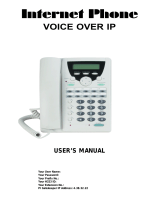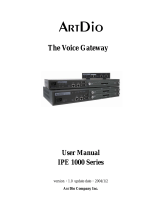Page is loading ...

User’s Manual
IP Telephony Gateway, FXO Interface
Model No.: SP5050 / SP5052 / SP5054
http://www.micronet.info

Table of Contents
1. INTRODUCTION .............................................................................................................. 4
1.1 FEATURES AND SPECIFICATION.................................................................................... 4
1.2 APPEARANCE ............................................................................................................. 6
2. SETTING UP THE GATEWAY (TCP/IP)........................................................................... 8
2.1 SYSTEM REQUIREMENTS ............................................................................................ 8
2.2 IP ENVIRONMENT SETTING.......................................................................................... 8
2.3 THE DEFAULT IP SETTINGS ........................................................................................11
2.4 FXO GATEWAY NETWORK CONFIGURATIONS.............................................................. 12
3. GETTING STARTED...................................................................................................... 17
3.1 SETTING UP THE CONSOLE CONNECTION .................................................................. 17
3.2 NETWORK CONFIGURATION....................................................................................... 21
3.3 CONFIGURE PEER-TO-PEER MODE............................................................................ 22
3.4 SAVING YOUR CONFIGURATIONS ................................................................................ 22
4. MAKING A VOIP CALL.................................................................................................. 23
4.1 P2P MODE (PEER-TO-PEER).................................................................................... 23
4.2 GK MODE (GATEKEEPER)......................................................................................... 26
4.3 ADVANCE CONFIGURATIONS...................................................................................... 28
4.4 IP SHARING.............................................................................................................. 28
5. WEB INTERFACE COMMAND...................................................................................... 30
5.1 NETWORK INTERFACE............................................................................................... 31
5.2 H323 INFORMATION.................................................................................................. 33
5.3 LINE CONFIGURATION ............................................................................................... 36
5.4 PHONE BOOK CONFIGURATION.................................................................................. 37
5.5 SUPPORT CONFIGURATION........................................................................................ 38
5.6 SYSTEM CONFIGURATION.......................................................................................... 39
5.7 VOICE CONFIGURATION............................................................................................. 42
5.8 PHONE CONFIGURATION (FXS ONLY)........................................................................ 44
5.9 RTP PAY LOAD TYPE CONFIGURATION....................................................................... 45
5.10 IP PACKET TOS........................................................................................................ 46
5.11 DDNS CONFIGURATION............................................................................................ 47
5.12 PREFIX CONFIGURATION ........................................................................................... 48
5.13 PASSWORD CONFIGURATION..................................................................................... 50
5.14 VERSION AND INFORMATION ...................................................................................... 51
1

5.15 ROM UPGRADE ....................................................................................................... 52
5.16 FLASH CLEAN........................................................................................................... 55
5.17 COMMIT ................................................................................................................... 55
5.18 REBOOT SYSTEM...................................................................................................... 55
5.19 TONE CONFIGURATION.............................................................................................. 56
5.20 ROUTING TABLE........................................................................................................ 57
5.21 FXO PASSWORD ...................................................................................................... 61
6. COMMAND LIST............................................................................................................ 62
6.1 [HELP]...................................................................................................................... 63
6.2 [QUIT]....................................................................................................................... 64
6.3 [DEBUG]................................................................................................................... 64
6.4 [REBOOT] ................................................................................................................. 65
6.5 [FLASH].................................................................................................................... 65
6.6 [COMMIT].................................................................................................................. 65
6.7 [IFADDR]................................................................................................................... 66
6.8 [TIME]....................................................................................................................... 68
6.9 [PING] ...................................................................................................................... 68
6.10 [SYSCONF]................................................................................................................ 69
6.11 [H323] ..................................................................................................................... 72
6.12 [LINE]....................................................................................................................... 76
6.13 [PREFIX]................................................................................................................... 78
6.14 [PBOOK]................................................................................................................... 79
6.15 [VOICE]..................................................................................................................... 81
6.16 [SUPPORT]................................................................................................................ 83
6.17 [SYSINFO]................................................................................................................. 84
6.18 [ROUTE] ................................................................................................................... 85
6.19 [TONE]...................................................................................................................... 87
6.20 [FXOPW]................................................................................................................... 89
6.21 [RECORD]................................................................................................................. 90
6.22 [TOS]........................................................................................................................ 92
6.23 [DDNS] ..................................................................................................................... 93
6.24 [PT].......................................................................................................................... 95
6.25 [ROM]....................................................................................................................... 96
6.26 [PASSWD]................................................................................................................. 98
2

About this User’s Manual
This user’s guide gives hardware specifications and explains web
configuration and command line configuration for the FXO Gateway SP5052,
SP5054 and SP5050
Online Upgrade
Please refer to
http://www.micronet.info/ for additional support documentation.
General Syntax Conventions
y Mouse action sequences are denoted using a comma. For example, click
start, Settings, Control Panel, Network means first you click Start, Click or
move the mouse pointer over Settings the click or move the mouse pointer
over Control Panel and finally click (or double-click) Network.
y “Enter” means to type one or more characters.
y Predefined choices are in Bold Arial Font.
y Button and field labels, link s and screen names in are in Bold Times New
Roman font.
y A single keystroke is in Arial font and enclosed in square brackets. [Enter]
means the Enter.
y For brevity’s sake, we will use “e.g.,” as shorthand for “for instance”, and
“i.e.,” for “that is” or “in other words.”
Related Documentation
y This user’s guide provides hardware connection details and configuration
and management instruction for the managements FXO Gateway.
y Please refer to
http://www.micronet.info/ for additional support
documentation.
3

1. Introduction
Micronet SP5050 series VoIP FXO Gateway provides voice/fax service over IP
network with H.323 v4 protocol. By connecting to your existing ADSL or cable
modem service, which allows the use of a single, network for voice and fax
services with consequent saving in network infrastructure and greatly reduced
telephone charges. Ideal solution for providing low cost communications
between headquarters and branch offices in the world, as well as for SOHO
and office telephony applications.
Micronet SP5050 series Gateway provides FXO interface to connect PSTN
analog lines, and converts voice/fax signal onto IP network. You can manage it
via RS-232 console, TELNET, and web browser.
1.1 Features and Specification
General Features
z ITU-T H.323 v3 compliance
z Gatekeeper and Peer-to-Peer Mode
z Automatically Gatekeeper Discovery
z Secondary GK support
z Support auto-attendant (2nddial Tone / Voice greeting)
z Line hunting
z E.164 (Telephone Number Plan)
z DTMF dialing
z DTMF detection/generation
z TFTP software upgrade
z Remote configuration/reset via Telnet
z LED indication for system status
z LAN interface : One RJ-45 connector of 10Base-T
z Microsoft Netmeeting v3.0 compatible
z Support static IP, DHCP and PPPoE
z QoS by ToS (Type Of Service)
z SNTP (Simple Network Time Protocol)
z Security: Password setting
z Silence Detection
4

Audio Features
z Codec: G.711 a/µ-law, G.723.1 (6.3kbps), G.729A (Optional)
z VAD (Voice Activity Detection), CNG (Comfort Noise Generate)
z G.168/165-compliant adaptive echo cancellation
z Dynamic Jitter Buffer
z Bad Frame Interpolation
z Call Transfer (H.450.2)
z Call Forward (H.450.3)
z Call Hold (H.450.4)
z Gain Settings
z Call Progress Tone: Dial , busy, call-holding and ring-back tone
Management Features
z Web Brower
z TELNET
z Console port: RS-232C port
Hardware Specification
SP5052 for 2 FXO RJ-11 ports
SP5054 for 4 FXO RJ-11 ports
SP5050 for 6 FXO RJ-11 ports
z Dimensions : 221mm(W)*42mm(H)*217mm(L)
z Weight : 2.3 Kg
5

1.2 Appearance
SP5050. Front Panel
(1) Power: Light on means Micronet SP5050 is power on.
(2) L1-L6: Light on means the line is in use.
(3) Link: Light on means Micronet SP5050 is connected to the network
correctly.
(4 ) Act: LED should be light on and in flash display when data is
transmitting.
(5) Ready: Light on and in slow flash means Micronet SP5050 is in
operation mode.
(6) Status: 1. Light on means Micronet SP5050 successfully registered to
Gatekeeper when it is set as Gatekeeper Mode.
2. LED flash means Micronet SP5050 is not registered to
Gatekeeper when it is set as Gatekeeper Mode.
3. When Micronet SP5050 is in downloading mode, LED should
be flash as well.
4. Light off means Micronet SP5050 is in Peer-to-Peer Mode.
SP5050 Back Panel
(1) Ethernet Port
Ethernet port is for connecting the gateway to network, supporting Ethernet
10Base-T.
6

The pin-out is as following:
PIN 1, 2: Transmit
PIN 3, 6: Receive
(2) LINE:
RJ-11 connector, FXO interface is for connecting the extension line of PABX or
PSTN Line.
(3) COM:
RS232 console port (DB-9 male connector)
Note: use straightforward cable to connect to your computer.
PINOUTS
Pin Name Dir Description
2 RXD Receive Data
3 TXD Transmit Data
5 GND System Ground
(4) Power Switch
(5) AC Power: 100V~120 VAC power supply.
7

2. Setting Up the Gateway (TCP/IP)
2.1 System Requirements
PC : (a) Pentium 100 or above, 64 RAM, Windows 98 or above;
(b) Ethernet card or COM port
(c) One RS-232 cable: standard straight-forward
(female connector to Gateway side).
Telephone Line : PBX extension Lines or PSTN Lines.
Software: Hyper Terminal, TELNET or Web Browser
Gatekeeper (optional).
Note:
Since the Line function feature starts from L1, please plug the telephone lines
from L1.
2.2 IP Environment Setting
User must prepare a valid IP address for Gateway’s proper operation.
For testing the validation of chosen IP address, using the same IP
configuration in other PC or Notebook, and then try to connect to Public
Internet (go to well-known website, receive Internet mail, or ping a specific
public IP address). If it works, use the same IP address and network
configuration for Gateway.
Please follow up the steps for the configuration of your computer or notebook.
8

For Windows user
Please make sure that the network interface of your computer is working and
the cross-over line (RJ-45) is connecting with the computer correctly or you
could use a switch or hub to connect with your computer and this Gateway.
1. Select your PC network adapter’s Properties
2. Select the Internet Protocol(TCP/IP) and click Properties
9

3. Select Advanced... option
4. Click Add to enter new IP address
10

5. Enter the new IP address and click Add
6. Click OK to finish PC network configurations.
2.3 The Default IP Settings
IP : 10.1.1.3
Subnet : 255.255.0.0
Default Gateway : 10.1.1.254.
11

2.4 FXO Gateway Network configurations
1. Key in the IP address of the Gateway (http://10.1.1.3) with the browser
2. After key in the IP address, you have to enter the user name and
password to enter the WEB configuration. (Username: root; No
password)
12

3. You will enter the main page of the configuration after key in the login
name and password correctly:
4. Press the Network Interface to configure the networking of your Gateway:
Static IP address
1. Please get the correct IP address, Subnet and default Gateway address
from your ISP first. Press the OK button if you finished.
13

2. Press the commit if you finish the configuration.
3. Press the reboot if you want the configuration executed.
14

DHCP mode
1. Enable the DHCP if you are using the cable modem or DHCP server.
2. Please commit the data and reboot the machine after you enable the
DHCP function.
PPPoE mode
1. Select the PPPoE Configuration and put the info of the PPPoE account
and password in the configuration table.
15

2. Please commit the data and reboot the machine after you finished the
configuration of PPPoE.
16

3. Getting Started
This section outlines how to connect your VoIP Gateway to the LAN and the
WAN. In the case of connecting a Cable Modem you must connect the coaxial
cable from your cable service to the threaded coaxial cable connect on the
back of the cable modem.
3.1 Setting Up the Console Connection
For the initial configuration of your VoIP Gateway, you need to use terminal
emulator software (Hyper Terminal for example) on a workstation and connect
it to the VoIP Gateway the console port. Connect the 9-pin end of the console
cable to the console port of the VoIP Gateway and the other end to a serial port
(COM1, COM2 or other COM port) of your workstation. You can use an
extension RS-232 cable if the enclosed one is too short. After the initial setup,
you can modify the configuration remotely through telnet connections.
1. Connect your computer and VoIP gateway with serial cable
17

2. Run Hyper Terminal program (Windows XP)
Start Æ Programs Æ Accessories Æ Communications Æ Hyper Terminal
3. Select the COM port
18

4. Configure the COM port Properties
Terminal Program is ready
19
/







